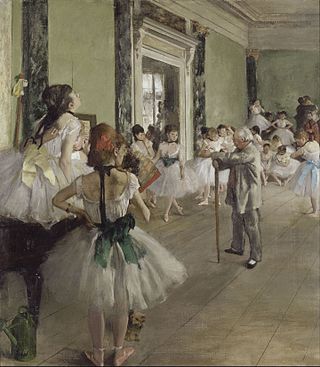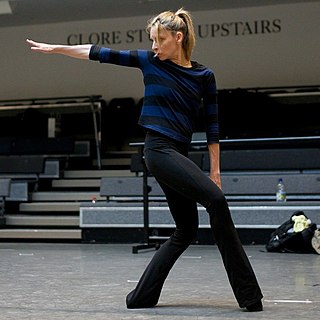Related Research Articles

Coppélia is a comic ballet from 1870 originally choreographed by Arthur Saint-Léon to the music of Léo Delibes, with libretto by Charles-Louis-Étienne Nuitter. Nuitter's libretto and mise-en-scène was based upon E. T. A. Hoffmann's short story Der Sandmann. In Greek, κοπέλα means young woman. Coppélia premiered on 25 May 1870 at the Théâtre Impérial de l'Opéra, with the 16-year-old Giuseppina Bozzacchi in the principal role of Swanhilda and ballerina Eugénie Fiocre playing the part of Frantz en travesti. The costumes were designed by Paul Lormier and Alfred Albert, the scenery by Charles-Antoine Cambon, and Édouard Desplechin and Jean-Baptiste Lavastre.

Dame Adeline Genée DBE was a Danish-British ballet dancer.
Lucia Cormani was a 19th and early 20th-century Italian ballet dancer and one of the founders of the Royal Academy of Dance.

A ballet master is an employee of a ballet company who is responsible for the level of competence of the dancers in their company. In modern times, ballet masters are generally charged with teaching the daily company ballet class and rehearsing the dancers for both new and established ballets in the company's repertoire. The artistic director of a ballet company, whether a male or female, may also be called its ballet master. Historic use of gender marking in job titles in ballet is being supplanted by gender-neutral language job titles regardless of an employee's gender.

The Salle Le Peletier or Lepeletier was the home of the Paris Opera from 1821 until the building was destroyed by fire in 1873. The theatre was designed and constructed by the architect François Debret on the site of the garden of the Hôtel de Choiseul on the rue Lepeletier. Due to the many changes in government and management during the theatre's existence, it had a number of different official names, the most important of which were: Théâtre de l'Académie Royale de Musique (1821–1848), Opéra-Théâtre de la Nation (1848–1850), Théâtre de l'Académie Nationale de Musique (1850–1852), Théâtre de l'Académie Impériale de Musique (1852–1854), Théâtre Impérial de l'Opéra (1854–1870), and Théâtre National de l'Opéra (1870–1873).
bbodance, formerly the British Ballet Organization (BBO), is a dance examination board based in London, England.
The Sergeyev Collection is a collection of choreographic notation, musical materials, designs for décor and costumes, theatre programs, photos and other items that document the repertory of the Imperial Ballet of St. Petersburg, Russia at the turn of the 20th century. The majority of the choreographic notations document the original works and revivals of the choreographer Marius Petipa, who served as Premier Maître de ballet of the St. Petersburg Imperial Theatres. The collection also documents a few ballets by Lev Ivanov, who served as second Maître de ballet. Also included in the collection are choreographic notations documenting the choreography for the dances of various operas by both Petipa and Ivanov, respectively.
Sir Anthony James Dowell is a retired British ballet dancer and a former artistic director of the Royal Ballet. He is widely recognized as one of the great danseurs nobles of the twentieth century.

Katti Lanner was a Viennese ballet dancer, choreographer, and ballet mistress who found fame in Germany and England, where she staged many productions at the Empire Theatre in London.
The Original Ballet Russe was a ballet company established in 1931 by René Blum and Colonel Wassily de Basil as a successor to the Ballets Russes, founded in 1909 by Sergei Diaghilev. The company assumed the new name Original Ballet Russe after a split between de Basil and Blum. De Basil led the renamed company, while Blum and others founded a new company under the name Ballet Russe de Monte-Carlo. It was a large scale professional ballet company which toured extensively in Europe, Australia and New Zealand, the United States, and Central and South America. It closed down operations in 1947.

Edouard Espinosa (1872–1950) was a British ballet dancer and teacher. He was also the co-founder of the Royal Academy of Dancing and established the British Ballet Organization.
Eve Louise Kelland (1889-1943) was an actress and singer.
Edward Kelland-Espinosa (1906–1991) was the son of Edouard Espinosa, founder of the British Ballet Organization (BBO), and his wife, Eve Louise Kelland.
Yvette Espinosa (1911–1992) was an English ballerina. She was born in England, the daughter of Eve Louise Kelland and Edouard Espinosa, founder of the British Ballet Organization.

The Polish National Ballet is the largest and most influential ballet company in Poland. It continues a ballet heritage, dating to the 17th century.
Nicholas Grigoryevich Sergeyev (1876–1951) was a Russian ballet dancer, choreographer and teacher, and regisseur of the Imperial Ballet at the Maryinsky Theatre, St Petersburg. He fled Russia in 1919 and spent the rest of his life in the West, producing ballets for many of the leading western companies of the time. He is remembered for preserving what is now called the Sergeyev Collection for future generations.
Emma Amalia Virginia Palladino was an Italian ballet dancer who for seven years was the prima ballerina at the Alhambra Theatre in London where she danced to the ballet music of the theatre's resident composer and conductor Georges Jacobi.

Antonia Franceschi is an American actress, dancer, and choreographer.
Andrey Eduardovich Klemm is a Russian born ballet dancer, ballet teacher, author and choreographer.
Madame Ravodna was a French-born ballet teacher and member of the Espinosa family.
References
- 1 2 3 4 5 6 7 8 "Espinosa, Edouard". Encyclopedia. Retrieved 2022-01-04.
- 1 2 "History". BBOdance. Retrieved 2022-01-04.
- ↑ "Edouard Espinosa and the world of early British ballet". Vintage Pointe. Retrieved 2022-01-04.
- ↑ "Theatre Heritage Australia - Betty Pounder: The centenary of a remarkable life (Part 1)". www.theatreheritage.org.au. Retrieved 2022-01-04.
- 1 2 3 "History". London Studio Centre. Retrieved 2022-01-04.
- ↑ "Espinosa, Judith (1877–1949)". Encyclopedia. Retrieved 2022-01-04.